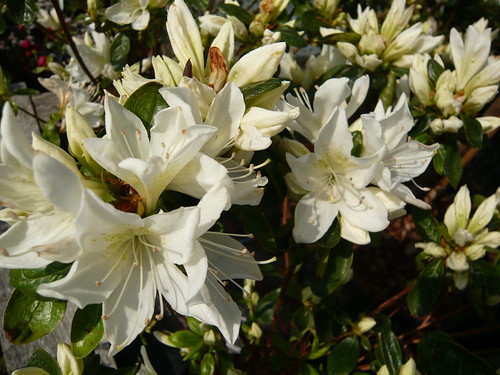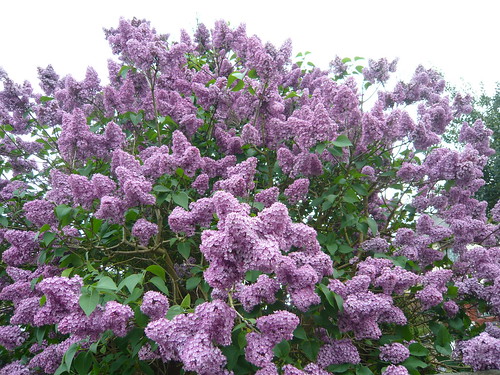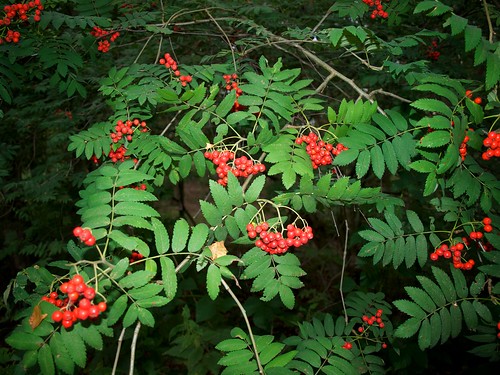Roses Spring and Summer
The spring light is shining through this crystal clear white rose that may well be the emblematic White Rose of Yorkshire. To get attractive blooms and glossy foliage try the following tips.
Articles involving trees, shrubs, bushes, woods and hedges plus related subjects
The spring light is shining through this crystal clear white rose that may well be the emblematic White Rose of Yorkshire. To get attractive blooms and glossy foliage try the following tips.
A lazier shrub with exciting blossom I have yet to find.

How do you tell an Azalea from a Rhododendron? Most Azaleas have only 5 or 6 stamen while most rhododendrons have 10 stamen. Azalea leaves tend to be thinner, softer and more pointed than rhododendron leaves.
In a subjective way I think Azaleas produce more flower cover per plant.

Lilacs (Syringa vulgaris ) are one of the most rewarding spring or early summer flowering shrubs. It rewards us with the most delicate fragrance and beautiful flowers. Even when not in flower, the lilac makes a nice attractive deciduous, green leaved shrub, that can form part of a hedge or shelter the garden.


Lilacs: A Gardener’s Encyclopedia by John L. Fiala and Freek Vrugtman
‘The new book provides up-to-date information on the 21 known lilac species and 10 natural hybrids, as well as hundreds of the 2000 named cultivars.’
English Elms have been dying in there millions since the 1970’s. A further outbreak of Dutch Elm disease in the 1990’s make the growing of Elm in the UK a dangerous business.
Read about our series on British tree reviews with a bakers dozen fact sheets
Credits
Elm tree in spring by BillLongstaff CC BY-SA 2.0
Another one bites the dust by Unhindered by Talent CC BY-SA 2.0 ‘Another elm in our neighborhood succumbs to Dutch Elm, making 5 or 6 big boulevard elms that have been removed around our corner in the last few years.
These were gorgeous old trees, which provided us with shade in the summer and shelter from January’s bitter north winds. We’re working on planting new trees, but those will be more for the next generation than ours.’
Special Elm Trees by Island 2000 Trust Conservation CC BY-NC 2.0 ‘Our elm project aims to in part replace the many thousands of English Elms lost to the Island through Dutch Elm Disease with the resistant cultivar of Wych Elm Ulmus LUTECE. We buy in and distribute between 500 and 1000 every year and we’re now in our 4th year of the scheme. The original work on LUTECE was done by Butterfly Conservation and Andrew Brookes at Portsmouth University particularly with regard to the conservation of White-letter Hairstreak. We’re on the look-out for more resistant strains too, particularly those based on English Elm.”Here are some of our special resistant LUTECE elms about to be planted out in Totland. West Wight has suffered dreadfully from the renewed outbreaks of DED since 1995 and we’re keen to do what we can to restore an elm component to the landscape. There’s still plenty of elm at a lower level in hedges and as suckers from felled or dead taller trees but there are almost none left as field and hedgerow trees. These are alongside One Horse Field (a Gift to nature Project).’
The Rowan or Mountain Ash is a member of the same family as the rose and is part of the large Sorbus genus. The trees can be quite singular in appearance when shaped by wind on high moors and mountains.
Credits
Rowan DSCF8583 by hedgerowmobile CC BY-NC-SA 2.0
Mountain panorama with rowan by moonlightbulb CC BY 2.0
Lijsterbes by ednl CC BY 2.0
Read about our series on British tree reviews with a bakers dozen fact sheets

If you want a quick wind break or tall hedge then Leylandii may be the tree for you. If you to annoy the neighbors then this is the tree most likely to cause friction.
Read about our series on British tree reviews with a bakers dozen fact sheets
Credits
leyland cypress cones DSCF7563 by hedgerowmobile CC BY-NC 2.0
Leylandii Sky by steve_w, CC BY-NC-ND 2.0
Spring is known for colourful bulbs and primula but there are many top shrubs that provide great colour in spring.
Forsythia The yellow flowering twiggy shrub that can grow to 10 feet. It flowers before the leaves form and is a strong, bright yellow. Large blossom varieties are now being cultivated but either way you get a mass of bloom.
Rhododendron Evergreen shrubs of many forms and sizes from 12 inches to 12 foot. Some bloom from March and some in May. Many sizes and colors exist and one range is named after Snowwhite’s seven dwarfs.
Ribes sanguineum Red Flowering Currant 6′ by 4’ This easy deciduous shrub flowers in panicles of red or pink in March and April.
Mahonia aquifolium ‘Compacta’Oregon Grape Evergreen shrubs with spiky leaves grow to several feet tall. Yellow flowers in February and March with good scent. It also produces black edible berries. …
Skimmia is a slow growing, aromatic, evergreen shrub with a compact habit. Skimmia Japonica grows in a dome shape with leathery leaves and the flowers can be followed by red or black berries. Skimmia laureola has dark green leaves which smell when crushed. The flowers on this variety are clustered on the end of the shoots.
How and Where Can I Grow Skimmias?
My attempts at Bonsai have not been as successful as I would have wished. After a talk and practical demonstration at our local gardening club I was fired with enthusiasm but not patience.
I bought the training pots and wired some trees two seasons ago and they look similiar to when I planted them. I was fortunate to have been shown how to take a 4 foot high tree down to bonsai size rather than growing a seedling in a pot as I had assumed you needed to do. At the Harrogate Autumn show there was another practical demonstration that also showed how to wire and twist branches to look like older drooping branches.
After another winter outside I will tidy up my attempts and have another go in Spring. I think it would be satisfying to achieve an example similar too the one above or even something close. To do that I need a book from amazon or Santa.
What colours predominate in the grey winter days when greens seem muddy and mud seems very grey. Well I like golden yellow colours and here are a couple of January examples that didn’t take much trouble finding in the garden during a short sunny spell.
Lonicera nitida ‘Baggesen’s Gold’ tips you off in the title. This relative of the honeysuckle is grown for its leaf and the ability to prune to shape. It will not flower and is easy to propagate from cuttings. Unpruned the leaves can appear bicoloured but young growth will be fresh and bright golden coloured. It is easy to prune and a very forgiving shrub. Close up these small ovate leaves are not made from gold leaf unfortunately.
Choisya ternata Sundance was another yellow shrub doing its best in the weak January sun this afternoon. If the winter is too prolonged some young yellow leaves may get slightly frost burnt but despite -8 degrees last week these shrubs are still showing well. I also like the smell of bruised leaves and the delicate white spring blossom. This golden wonder performs even in a crisp winter frost.